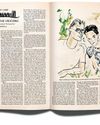Try GOLD - Free
THE ROOF IS ON FIRE
The New Yorker
|August 25, 2025
Was it racial capitalism that burned the Bronx?

An abandoned tenement burns in the South Bronx, in August, 1977, near the peak of an arson wave in the city.
ALAIN LE GARSMEUR/ALAMY; OPPOSITE: PIERRE BUTTIN
Sometimes people say exactly the right thing. Other times, they don't, and we just pretend that they did. When eighteenth-century Parisians clamored for bread, did Marie Antoinette respond, “Let them eat cake”? No, but the line captures the aristocracy’s witlessness. Patrick Henry probably never said “Give me liberty, or give me death,” either.
The second game of the 1977 World Series, at Yankee Stadium, provided another such occasion. It was a time of crushing austerity for New York City; tens of thousands of municipal employees had been laid off, including firefighters. These woes were background to the game, but they flashed into the foreground when a fire in an abandoned elementary school lit up the skies just blocks away. “Ladies and gentlemen,” the announcer Howard Cosell famously but never actually said, “the Bronx is burning.”
Indeed, it was. “It seemed like just every second there was a fire,”Darney (K-Born) Rivers, a local rapper, later recalled. “I’m talking about every block you went on.” Families kept suitcases by the door; children were told to wear shoes to bed.
To some, this was a tragic turn in the country’s racial drama. White people left cities for the suburbs, taking jobs and tax revenues with them. Black people, trapped in neighborhoods that felt increasingly like holding pens, revolted. The Watts uprising of 1965, in Los Angeles, incinerated hundreds of buildings. The fires continued. The historian Elizabeth Hinton, in “America on Fire” (2021), counts 1,949 urban insurgencies between May, 1968, and December, 1972.
This story is from the August 25, 2025 edition of The New Yorker.
Subscribe to Magzter GOLD to access thousands of curated premium stories, and 10,000+ magazines and newspapers.
Already a subscriber? Sign In
MORE STORIES FROM The New Yorker

The New Yorker
THE TALK OF THE TOWN
The militarization of American cities, including Los Angeles, Portland, and Chicago, has brought home a perverse irony. T
4 mins
October 20, 2025

The New Yorker
THIS IS MISS LANG
The brief life and forgotten legacy of a remarkable American poet.
19 mins
October 20, 2025

The New Yorker
RAMBLING MAN
Peter Matthiessen's quest to escape himself—at any cost.
15 mins
October 20, 2025

The New Yorker
DEGREES OF HOSTILITY
How far will the Administration's assault on colleges and universities go?
26 mins
October 20, 2025

The New Yorker
GOINGS ON
What we're watching, listening to, and doing this week.
6 mins
October 20, 2025

The New Yorker
READY OR NOT
Zohran Mamdani wants to transform New York City. Will the city let him?
37 mins
October 20, 2025

The New Yorker
Alexandra Schwartz on Joan Acocella's "The Frog and the Crocodile"
When I am stuck on a sentence or trying to wrestle an idea into shape, I turn to Joan Acocella.
3 mins
October 20, 2025

The New Yorker
A BROTHER'S CONVICTION
Did a grieving man's quest for justice go too far?
43 mins
October 20, 2025

The New Yorker
THE KEY TO ALL MYTHOLOGIES
Why the quest for a master code goes on.
13 mins
October 20, 2025

The New Yorker
FOR ART'S SAKE
\"Blue Moon\" and \"Nouvelle Vague.\"
6 mins
October 20, 2025
Listen
Translate
Change font size
